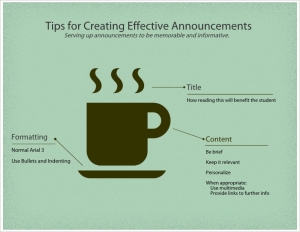In the Blendkit 2014 MOOC this week, the work is focused on integrating the online and face-to-face (f2f) portions of the course. It is key that the two complement and build on each other. However, it is the instructor at the f2f level that must be most prepared to do that integration. The online course is typically set up and structured so all students, regardless of instructor, are provided with the same resources and assessments. It’s what happens in the classroom that should be the focus of the blended learning instructor training. Many adjunct instructors are professionals with little to no educational background (outside of what they themselves experienced in college). They must be taught and mentored how to recognize what concepts need more focus in the classroom and what to do to address them. By working in conjunction with the online course, particularly using formative assessments, the instructor can identify these concepts ahead of time. It’s those activities that are done in the classroom that must be targeted in the training. What groups activities can be done to get students working and discussing those items that they struggled with? It is in the classroom where the flexibility and individualization of learning can occur within the blended learning environment. Having a mentor/instructional coach work with the instructor/s on a weekly basis to do the planning of the weekly classes could be extremely beneficial that first time the instructor teaches the class and then regular check ins after that. Meeting with the instructors of these blended courses as a small group may also be very helpful to everyone involved as they could develop a professional learning community, mimicking what they are trying to do in their courses. Course visits to evaluate how the activities are going would also be important by the mentors as well as the other instructors. This way the students and the instructor are receiving the optimum educational experience and the full integration of both online and f2f components of blended learning is achieved.
Teaching
What is a curator?
Recently I heard one of my colleagues use the term curator and then I read an article by Marcia Devlin, Online learning calls for new set of skills http://www.theage.com.au/national/education/online-learning-calls-for-new-set-of-skills-20121022-28156.html#ixzz2A9HYOy48 where she states:
The role of educators as “sense makers” is becoming increasingly critical. The educator has begun to move from being the creator, holder and deliverer of knowledge to being the aggregator of knowledge and the guide and facilitator of learning.
When I looked up what a curator is in education, I discovered that it is exactly what Ms. Devlin is describing – an aggregator of knowledge. It is very common when teaching online classes (whether higher ed or K-12) that the content cannot be modified in the course. Teachers must find a way to collect (curate) the latest developments and provide them to students. One way I have also discovered is to use Scoop.it, specifically designed to provide links to articles and information students would find useful.
How do you provide additional content to your students in your online course/s?
Understanding Weighted Grades in Blackboard
You can set your course grade to be weighted based on categories and/or individual assignments. Categories group the different types of assignments. You can then assign a percentage weight to each category or assignment. When a category is used, the individual assignments in the category are weighted equally. For example, if you have 5 discussion forums and this represents 20% of the grade, each forum is worth 4% of the grade. It is only when you want the individual assignments within a category to be weighted differently will you weight each assignment rather than the category. In terms of the calculations to confirm the weighted grade, the fewer number of weights, the easier the calculation.
For example, in your syllabus, you may have discussion forums worth 20%, papers worth 40%, a midterm exam worth 20%, and the final exam worth 20%. These are your categories: discussion forums and papers. The midterm exam and final exam are weighted as individual assignments. When you create your forum and paper assignments, assign each to the appropriate category. Set up the correct weights in the weighted column in the Blackboard Grade Center and it will automatically calculate the weighted total. If this column does not exist, consult your APM to have it created.
Sometimes, it may appear when you look at the points and the weighted column value that the weighted value does not reflect the points accurately. This is entirely due to the assignment of the weights. You cannot add up earned points and divide by total points to get this value. Weighted grades have to take into consideration the weights of each category.
This is how the weighted grade is calculated to arrive at a final percentage.
For each category, add up the total points earned and the total possible points. Since not all assignments in the category may be completed, only include the ones that have scores, including assignments for which the earned grade is zero (any ungraded assignments will not have a numerical score). Divide total points earned by total possible points and multiply by the percentage value. This gives you the number of percentage points that this category contributes to the final grade.
For example, using a forums category, a student may have earned 25 points out of a possible 30 points. The category is worth 20% of the grade. The calculation becomes (25/30) x 20 = 16.67. This means that the student earned 16.67 out of the possible 20 percentage points.
To calculate an interim grade comprised of some but not all of the categories, you must calculate the points that the student earned in each category involved. Add them up then multiply by the result of 100 divided by the total percentage points involved.
For example, assume the student earned 16.67 points for forums weighted at 20% and 25 points for papers weighted at 30%. Adding these points together, you get 41.67. Since this is 50% of the final grade, we have to multiply this 41.67 by two to get a grade out of 100. Therefore the calculation becomes (16.67+25) x (100/50) = 83.34.
To arrive at the final grade, calculate the points earned by the student in each category and add them all up. That will give you the final percentage out of 100. No further calculation is required.
You can see that using weights makes the calculation of the interim or final percentage grade more complicated and requires some work to verify that the percentage is correct. However, it can allow for a fairer grade for the student based on weighing the effort/importance on each type of assignment.
The Power of Feedback
I received permission to share this from an instructor in one of my training courses:
In sixth grade, I was not only very short, but spindly and uncoordinated. My least favorite class was gym, where the teacher was one of those stereotypical “drill sergeant” types. One day we girls were playing softball outside while the boys’ gym class exercised nearby. I was up to bat. I quickly made two strikes and then hit the ball so weakly that it was immediately picked up. I never made it to first base. In a disgusted tone that I can still hear in my head, my instructor loudly berated me as the puniest, weakest little thing she’d ever seen in her life
I felt completely humiliated. I was sure that everyone, including the boys, was laughing at me. As a result, I found ways to avoid taking my turn at bat (or participating in almost any organized sport) throughout my years at school. I never improved at softball, for example, and avoid team sports to this day.
For those of you that work in a role where you have to judge the performance of others, be it at a school or in an office building, please be extremely conscious of the impact of your words. There can be far reaching and extremely damaging results. Just think of how a positive and constructive response could have made a difference for this person in the other direction.
Have you ever had feedback that was particularly damaging or uplifting in your life?
Plagiarism and the Adult Learner
Using another’s written work either by blatant copy-and-paste or by poor paraphrasing amounts to the same thing : plagiarism. When I taught high school mathematics, I assigned a report on a famous mathematician and I was pleased with the results. As I tapped the set of papers on my desk to straighten them out, I noticed one report was shorter than the others – the bottom of each page had been cut off. I quickly did a search for a sentence in the report and discovered the entire paper online. This student had simply cut off the reference information that was printed at the bottom of each page. Needless to say I checked the rest of the papers as well and thankfully, found no further plagiarism.
When I started to do some research into adult online learners and plagiarism, I was hoping that being an adult implied a higher sense of integrity. However, plagiarism was still an issue and it really does not matter if they are online or not. Detection software is the key to deterring it. All written work is available electronically and can be subjected to an online plagiarism checker, such as TurnItIn. An interesting article about a study at Penn State’s World Campus in the Geographic Information Systems certificate program discusses Plagiarism by Adult Learners Online: A case study in detection and remediation. Well worth reading!
How do you handle plagiarism in your courses, online or face-to-face?
Synchronous Online Meetings
Sometimes there is a need or desire to hold a synchronous session in an online course. For instance, students may want to get together live to work on a group project or the teacher wants to have a live discussion about a current event or a particularly difficult concept. There are many tools out there to meet these various needs. Check out this post from “On Teaching Online” that explores Live (Synchronous) Meeting Systems Tools. It does not address Google+ Hangouts which is another popular informal video conferencing tool.
Have you used anything else that the article does not mention? Was it effective?
How Higher Education Uses Social Media – Infographic
Here is an easy-to-understand infographic on how colleges can and do use social media. Teachers need to get on board with these tools to expand the classroom outside of the physical or virtual boundaries of the class. This is a great way to add current content that builds upon what is being studied in class and to continue to engage students with the teacher, each other, and the topics.
History of Online Education – Infographic
Did you know that distance learning started in 1728 and that Sassafrass the poodle actually earned a diploma in 1984?
Check out this great infographic on the history of online education!
Online Discussion Participation
To get the most of an online discussion, there are things that the instructor needs to do and there are guidelines for the participant as well. Here is a short yet informative list of guidelines to use when participating in an online discussion forum. I particularly like the one about jotting down notes as you read other posts so you can prepare better for your responses.

